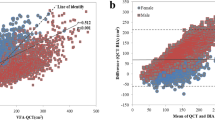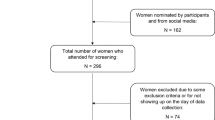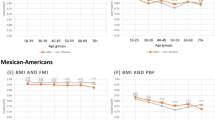Abstract
Background/Objectives:
The aim of this study was to verify the agreement between body fat percentage (%BF) values evaluated by air displacement plethysmograph (ADP) and body adiposity index (BAI) in adults with Down’s syndrome (DS).
Subjects/Methods:
Forty-five adults with DS volunteered to participate in this study (19 women; age 28.7±8.5 years and 26 men; age 29.1±8.8 years). The %BF was measured by ADP (%BFADP) and estimated by anthropometric measures [%BF=(hip circumference/height)1.5−18] (%BFBAI). Agreement between methods was evaluated by paired t-test, Pearson’s correlation coefficient and Bland–Altman analysis.
Results:
Although high correlation coefficients were found between %BFADP and %BFBAI for women (r=0.78, P<0.05) and men (r=0.87, P<0.05), significant differences were observed between methods for both sexes (38.9±8.9 vs 42.5±8.5% for women, and 25.8±11.3 vs 32.6±5.4% for men in %BFADP and %BFBAI, respectively). Moreover, Bland–Altman analysis showed that the mean error estimate was +3.6 (95%CI, −7.59 to 14.79) in women and +6.74 (95%CI, −7.25 to 20.72) in men.
Conclusions:
The results indicate that BAI seems to be a limited method to evaluate %BF in women and in men with DS.
This is a preview of subscription content, access via your institution
Access options
Subscribe to this journal
Receive 12 print issues and online access
$259.00 per year
only $21.58 per issue
Buy this article
- Purchase on Springer Link
- Instant access to full article PDF
Prices may be subject to local taxes which are calculated during checkout

Similar content being viewed by others
References
Bertapelli F, Pitetti K, Agiovlasitis S, Guerra-Junior G . Overweight and obesity in children and adolescents with Down syndrome—prevalence, determinants, consequences, and interventions: a literature review. Res Dev Disabil 2016; 57: 181–192.
González-Aguëro A, Ara I, Moreno LA, Vicente-Rodríguez G, Casajús JA . Fat and lean masses in youths with Down syndrome: gender diferences. Res Dev Disabil 2011; 32: 1685–1693.
Rimmer JH, Yamaki K . Obesity and intellectual disability. Ment Retard Dev Disabil Res Rev 2006; 86: 1461–1464.
Vis JC, Duffels MG, Winter MM, Weijerman ME, Cobben JM, Huisman SA . Down syndrome: a cardiovascular perspective. J Intellect Disabil Res 2009; 53: 419–425.
Winnick J . Adapted Physical Education and Sports. Human Kinetics Publishers: Champaign, IL, USA, 2010.
Roizen NJ, Patterson D . Down’s syndrome. Lancet 2003; 361: 1281–1289.
Bell AJ, Bhate MS . Prevalence of overweight and obesity in Down’s syndrome and other mentally handicapped adults living in the community. J Intellect Disabil Res 1992; 36: 359–364.
McCrory MA, Mole PA, Gomez TD, Dewey KG, Bernauer EM . Body composition by air-displacement plethysmography by using predicted and measured thoracic gas volumes. J Appl Physiol 1998; 84: 1475–1479.
González-Aguëro A, Vicente-Rodríguez G, Ara I, Moreno LA, Casajús JA . Accuracy of prediction equations to assess percentage of body fat in children and adolescents with Down syndrome compared to air displacement plethysmography. Res Dev Disabil 2011; 32: 1764–1769.
Casey AF . Measuring body composition in individuals with intellectual disability: a scoping review. J Obes 2013; 628428: 1–6.
Nickerson BS, Esco MR, Bicard SC, Russel AR, Williford HN, Schaefer G . Validity of the body adiposity index in adults with down syndrome. Res Dev Disabil 2015; 38: 92–96.
Usera PC, Foley JT, Yun J . Cross-validation of field-based assessments of body composition for individuals with down syndrome. Adapt Phys Activ Q 2005; 22: 198–206.
Bergman RN, Stefanovski D, Buchanan TA, Sumner AE, Reynolds JC, Sebring NG . A better index of body adiposity. Obesity 2011; 19: 1083–1089.
Siri WE Body composition from fluids spaces and density: analyses of methods. In: Brozek J, Henschel A (eds). Techniques for Measuring Body Composition. National Academy of Science and Natural Resource Council: Washington, DC, USA, 1961, pp 223–244..
Lohman TG . Skinfolds and body density and their relation to body fatness: a review. Hum Biol 1981; 53: 181–225.
Bland JM, Altman DG . Statistical methods for assessing agreement between two methods of clinical measurement. Lancet 1986; 1: 307–310.
Lohman TG . Advances in Body Composition Assessment: Current Issues in Exercise Science. Human Kinetics Publishers: Champaign, IL, USA, 1992.
Freedman DS, Thornton J, Pi-Sunyer FX, Heymsfield SB, Wang J . The body adiposity index (hip circumference/height(1.5)) is not a more accurate measure of adiposity than is BMI, waist circumference, or hip circumference. Obesity 2012; 20: 2438–2444.
Geliebter A, Atalayer D, Flancbaum L, Gibson CD . Comparison of body adiposity index (BAI) and BMI with estimations of % body fat in clinically severe obese women. Obesity 2013; 21: 493–498.
Esco MR . The accuracy of the body adiposity index for predicting body fat percentage in collegiate female athletes. J Strength Cond Res 2013; 27: 1679–1683.
Lemacks JL, Liu PY, Shin H, Ralston PA, Ilich JZ . (2012).Validation of body adiposity index as a measure of obesity in overweight and obese pos menopausal white women and its comparison with body mass index. Menopause 2012; 19: 1277–1279.
Rimmer JH, Kelly LE, Rosentswieg J . Accuracy of anthropometric equations for estimating body composition of mentally retarded adults. Am J Ment Defic 1987; 91: 626–632.
Wells JC, Fewtrell MS . Measuring body composition. Arch Dis Child 2006; 91: 612–617.
Author information
Authors and Affiliations
Corresponding author
Ethics declarations
Competing interests
The authors declare no conflict of interest.
Rights and permissions
About this article
Cite this article
Rossato, M., Dellagrana, R., de Souza Bezerra, E. et al. Comparison of body adiposity index (BAI) and air displacement plethysmograph with estimations of % body fat in adults with Down’s syndrome. Eur J Clin Nutr 71, 1341–1344 (2017). https://doi.org/10.1038/ejcn.2017.18
Received:
Revised:
Accepted:
Published:
Issue Date:
DOI: https://doi.org/10.1038/ejcn.2017.18
This article is cited by
-
Relative accuracy of body adiposity index and relative fat mass in participants with and without down syndrome
European Journal of Clinical Nutrition (2019)



